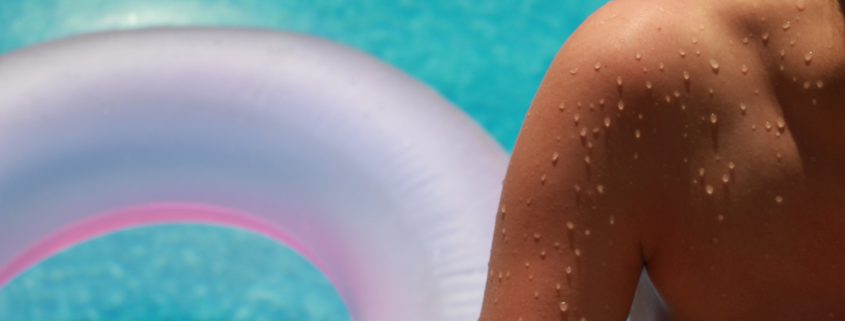UV-Filter in Kosmetika – Was machen sie und sind sie gefährlich ?
What is UV radiation?
UV radiation is a certain wavelength range of light that is more energetic than visible light. It occurs naturally, but is also artificially produced. It covers the ranges around 380-315nm (near UV / UV-A), 315-280nm (middle UV / UV-B) and 280-200nm (far UV / UV-C).[1]

Fig. 1 The sun, based on fusion, produces UV rays of all kinds.
Where does UV radiation occur?
UV radiation naturally occurs in the form of solar radiation. Here, the sun emits radiation from UV-A to UV-C (as well as some other wavelengths of the spectrum). Much of this radiation is absorbed by the ozone layer, which virtually eliminates UV-C, UV-A and UV-B. One can also generate UV radiation, e.g. by mercury or quartz lamps.[2]
What does UV radiation do and do we use it?
UV radiation has different uses, and different properties depending on the wavelength. However, they share some properties with each other. Thus, UV rays are invisible to the human eye, they can cleave chemical bonds and can denature proteins. We use UV radiation in a variety of things, such as as a harmless party light (black light), for the disinfection of surfaces, in analytics (spectroscopy) or in the solarium. UV-A radiation causes many light-related skin damage, UV-B radiation causes skin cancer. [3]
What are UV filters?
A UV filter is a substance that makes UV rays harmless infrared rays (heat radiation). There are filters for the UV-A, UV-B and UV-C range, as well as broadband filters covering several parts of these areas. These filters operate on the principle of Stokes shift. In this case, the absorption of UV radiation, a part of the energy is stored, and the radiation itself emits weaker (returned).[4]
Which UV filters are used in cosmetics and why?
UV filters are used as sunscreen, in lotion and creams. They protect cells and DNA from damage by UV-A and UV-B. Sunscreen products come in various "starches", which are classified under the sun protection factor (SPF). These range from an SPF of 6 (low) to an SPF of 50+ (very high). Such sunscreens provide organic substances, e.g. Benzophenone, benzylidene camphor or homosalate. Organic UV filters are usually derivatives of camphor, salicylic acid or cinnamic acid. Inorganic UV filters are e.g. Titanium dioxide (TiO2) or zinc oxide (ZnO). Nanoparticles are also used by these UV filters. [5]
Are UV filters in cosmetics dangerous?
UV filters can cause allergic and photoallergic reactions. Some UV filters can affect sex hormones, but this effect is clear in fish (feminization of fish), but does not seem to be relevant in humans. However, 4-methylbenzylidene camphor could not be excluded, this substance should be avoided. Also inorganic substances, like TiO2 and ZnO are not safe. TiO2 and ZnO are carcinogenic when inhaled (but sunscreen is only inhaled in powders and sprays), nanoparticles of titanium dioxide and zinc oxide have cytotoxic properties (ie they can damage cells and tissues), and they can form radicals by UV radiation. which can degrade organic material. Nanoparticles of these metal oxides can also be detected with lymphocyte transformation tests by some users. Zinc oxide penetrates only into the epidermis, titanium dioxide into the outermost layer of the skin (Latin stratum corneum).[6][7]
Are there alternatives to conventional UV filters?
Unfortunately, no. There is already research on alternatives and some promising candidates have been found. So far, however, there has been no clear 'Ok' for these substances. Substances such as; Avobenzone, amiloxate, bemotrizinol or octyltriazone have not yet been classified as toxic, but REACH and the responsible health authorities are awaiting evaluation. So far: From some substances such. 4-Methylbenylidene camphor should be kept away. People who are allergic to some organic UV filters should use TiO2 and ZnO (whitish products usually contain "normal" TiO2 and ZnO, while transparent ones often contain nanoparticles, which depends on you). As a basic idea, one should take the comparison of the risks, so the chance of skin cancer when not using sunscreen is higher than the risk of using it. For the sake of the environment, you should use solar protection a little more sparingly, and if you want to do without it, you have to protect yourself from the sun, for example, from the sun. through long clothes.[8]
Sources and information to read:
Scientific article on zinc oxide nanoparticles[6][7]
Scientific article on titanium dioxide nanoparticles [6][7]
Wikipedia[1][2][3][4][5][8]




Leave a Reply
Want to join the discussion?Feel free to contribute!